Evasion 28
Sailboat specifications
The Evasion 28 is a 26’2” (8m) motorsailer designed by André Bénéteau (France). She was built between 1975 and 1980 by Bénéteau (France) with 123 hulls completed.
Evasion 28's main features
- Model
- Evasion 28
- Hull type
- Monohull
- Category
- Motorsailer
- Sailboat builder
- Sailboat designer
- Sailboat range
- Country
- France
- Construction
- GRP (glass reinforced polyester):
- Hull: Single skin fiberglass polyester
- Deck: Sandwich balsa fiberglass polyester - Number of hulls built
- 123
- First built hull
- 1975
- Last built hull
- 1980
- Appendages
- Keel : full keel
- Helm
- Single helm wheel
- Rudder
- Single rudder on skeg
- Unsinkable
- No
- Trailerable
- No
- Former French navigation category
- 3
- Standard public price ex. VAT (indicative only)
- N/A €
Evasion 28's main dimensions
- Overall length
- 27’ 11”8.5 m
- Hull length
- 26’ 2”8 m
- Waterline length
- 21’ 8”6.6 m
- Beam (width)
- 9’ 6”2.9 m
- Draft
- 4’ 1”1.25 m
- Mast height from DWL
- 39’ 6”12.05 m
- Light displacement (MLC)
- 7518 lb3410 kg
- Maximum displacement (MLDC)
- 9480 lb4300 kg
- Capacity
- 1962 lb890 kg
- Ballast weight
- 3086 lb1400 kg
- Ballast type
- Cast iron
- French customs tonnage
- 6.17 Tx
Evasion 28's rig and sails
- Upwind sail area
- 477 ft²44.3 m²
- Downwind sail area
- 784 ft²72.8 m²
- Mainsail area
- 170 ft²15.8 m²
- Genoa area
- 307 ft²28.5 m²
- Jib area
- 117 ft²10.9 m²
- Stormjib area
- 46 ft²4.3 m²
- Symmetric spinnaker area
- 614 ft²57 m²
- Rigging type
- Sloop Marconi masthead
- Mast configuration
- Deck stepped mast
- Rotating spars
- No
- Number of levels of spreaders
- 1
- Spreaders angle
- 0 °
- Spars construction
- Aluminum spars
- Standing rigging
- 1x19 strand wire continuous
Evasion 28's performances
- Upwind sail area to displacementiThe ratio sail area to displacement is obtained by dividing the sail area by the boat's displaced volume to the power two-thirds.
The ratio sail area to displacement can be used to compare the relative sail plan of different sailboats no matter what their size.
Upwind: under 18 the ratio indicates a cruise oriented sailboat with limited performances especially in light wind, while over 25 it indicates a fast sailboat. - 210 ft²/T19.55 m²/T
- Downwind sail area to displacementiThe ratio sail area to displacement is obtained by dividing the sail area by the boat's displaced volume to the power two-thirds.
The ratio sail area to displacement can be used to compare the relative sail plan of different sailboats no matter what their size. - 346 ft²/T32.13 m²/T
- Displacement-length ratio (DLR)iThe Displacement Length Ratio (DLR) is a figure that points out the boat's weight compared to its waterline length. The DLR is obtained by dividing the boat's displacement in tons by the cube of one one-hundredth of the waterline length (in feet).
The DLR can be used to compare the relative mass of different sailboats no matter what their length:
a DLR less than 180 is indicative of a really light sailboat (race boat made for planning), while a DLR greater than 300 is indicative of a heavy cruising sailboat. - 336
- Ballast ratioiThe Ballast ratio is an indicator of stability; it is obtained by dividing the boat's displacement by the mass of the ballast. Since the stability depends also of the hull shapes and the position of the center of gravity, only the boats with similar ballast arrangements and hull shapes should be compared.
The higher the ballast ratio is, the greater is the stability. - 41 %
- Critical hull speediAs a ship moves in the water, it creates standing waves that oppose its movement. This effect increases dramatically the resistance when the boat reaches a speed-length ratio (speed-length ratio is the ratio between the speed in knots and the square root of the waterline length in feet) of about 1.2 (corresponding to a Froude Number of 0.35) . This very sharp rise in resistance, between speed-length ratio of 1.2 to 1.5, is insurmountable for heavy sailboats and so becomes an apparent barrier. This leads to the concept of "hull speed".
The hull speed is obtained by multiplying the square root of the waterline length (in feet) by 1.34. - 6.24 knots
Evasion 28's auxiliary engine
- Engine(s)
- 1 inboard engine
- Engine(s) power (min./max.)
- 15 HP / 30 HP
- Fuel type
- Diesel
- Fuel tank capacity
- 23.8 gal90 liters
Evasion 28's accommodations and layout
- Cockpit
- Closed aft cockpit
- Cabin(s)
- 1
- Berth(s) (min./max.)
- 2 / 5
- Head(s)
- 1
- Freshwater tank capacity
- 52.8 gal200 liters
- Fridge/ice-box capacity
- 11.1 gal42 liters
- Maximum headroom
- 6’1.82 m
Evasion 28's saloon
- Maximum headroom
- 5’ 10”1.76 m
Evasion 28's aft cabin
- Berth length
- 6’ 1”1.85 m
- Berth width
- 3’0.9 m

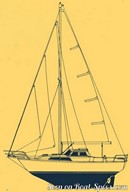



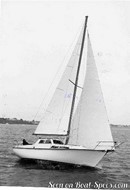
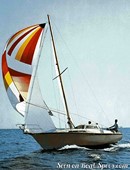
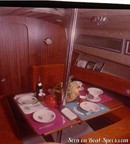

Bénéteau Evasion 28 interior and accommodations - - 8/11
Picture extracted from the commercial documentation © Bénéteau
Picture extracted from the commercial documentation © Bénéteau
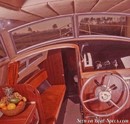

Bénéteau Evasion 28 interior and accommodations - - 9/11
Picture extracted from the commercial documentation © Bénéteau
Picture extracted from the commercial documentation © Bénéteau
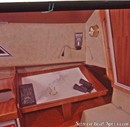

Bénéteau Evasion 28 interior and accommodations - - 10/11
Picture extracted from the commercial documentation © Bénéteau
Picture extracted from the commercial documentation © Bénéteau


Bénéteau Evasion 28 interior and accommodations - - 11/11
Picture extracted from the commercial documentation © Bénéteau
Picture extracted from the commercial documentation © Bénéteau
Similar sailboats that may interest you:
Sailboats
First built hull
Hull length
1986
28’8.54 m
1978
26’ 2”7.98 m
1985
28’ 11”8.8 m
1978
28’ 1”8.56 m
1975
26’ 11”8.2 m
1971
30’9.14 m
1975
26’ 5”8.05 m
1969
25’ 11”7.9 m
1982
27’ 11”8.5 m
1981
28’ 11”8.8 m
1980
22’6.7 m
1977
24’7.3 m
1973
29’ 6”9 m
1999
32’ 10”10 m
1967
33’ 1”10.1 m